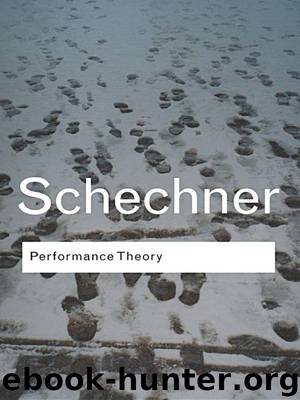Performance Theory (Routledge Classics) by Schechner Richard

Author:Schechner, Richard [Schechner, Richard]
Language: eng
Format: azw3
Publisher: Taylor and Francis
Published: 2004-05-31T16:00:00+00:00
The bottom line is solidarity, not conflict. Conflict is supportable (in the theater, and perhaps in society too) only inside a nest built from the agreement to gather at a specific time and place, to perform – to do something agreed on – and to disperse once the performance is over. The extreme forms of violence that characterize drama can be played out only inside this nest. When people “go to the theater”9 they are acknowledging that theater takes place at special times in special places. Surrounding a show are special observances, practices, and rituals that lead into the performance and away from it. Not only getting to the theater district, but entering the building itself involves ceremony: ticket-taking, passing through gates, performing rituals, finding a place from which to watch: all this – and the procedures vary from culture to culture, event to event – frames and defines the performance. Ending the show and going away also involves ceremony: applause or some formal way to conclude the performance and wipe away the reality of the show re-establishing in its place the reality of everyday life. The performers even more than the audience prepare and then, when the show is over, undertake “cooling-off” procedures. In many cultures this cooling off involves rituals to retire props or costumes or to assist performers out of trance or other non-ordinary states of being. Too little study has been made of how people – both spectators and performers – approach and leave performances. How do specific audiences get to, and into, the performance space; how do they go from that space? In what ways are gathering/dispersing related to preparation/cooling off?
The “theatrical frame” allows spectators to enjoy deep feelings without feeling compelled either to intervene or to avoid witnessing the actions that arouse those feelings. A spectator better not prevent the murders occurring in Hamlet. Yet these stage murders are not “less real” but “differently real” than what happens in everyday life. Theater, to be effective, must maintain its double or incomplete presence, as a here-and-now performance of there-and-then events. The gap between “here and now” and “there and then” allows an audience to contemplate the action, and to entertain alternatives. Theater is the art of enacting only one of a range of virtual alternatives. It is a luxury unaffordable in ordinary life. Oedipus would be much different if there were a plague afflicting the town where the drama was being played and the audience believed the plague would end if the murderer of their former mayor – a murderer they knew to be concealed in their midst – was found and brought to judgement here and now.
Some people want performance to achieve this level of actuality. As theater approaches this limit it changes fundamentally: small real actions are substituted for big fictional semblances. A female has her body scarred or a male is circumcised. These “real actions” are themselves emblems or symbols. But when the theatrical frame is imposed strongly it permits the enactment
Download
This site does not store any files on its server. We only index and link to content provided by other sites. Please contact the content providers to delete copyright contents if any and email us, we'll remove relevant links or contents immediately.
Call Me by Your Name by André Aciman(20351)
Ready Player One by Cline Ernest(14497)
How to Be a Bawse: A Guide to Conquering Life by Lilly Singh(7364)
Wiseguy by Nicholas Pileggi(5650)
The Kite Runner by Khaled Hosseini(5061)
On Writing A Memoir of the Craft by Stephen King(4847)
Audition by Ryu Murakami(4822)
The Crown by Robert Lacey(4710)
Call me by your name by Andre Aciman(4599)
Gerald's Game by Stephen King(4556)
Harry Potter and the Cursed Child: The Journey by Harry Potter Theatrical Productions(4429)
Dialogue by Robert McKee(4306)
The Perils of Being Moderately Famous by Soha Ali Khan(4156)
Dynamic Alignment Through Imagery by Eric Franklin(4100)
Apollo 8 by Jeffrey Kluger(3621)
Seriously... I'm Kidding by Ellen DeGeneres(3564)
The Inner Game of Tennis by W. Timothy Gallwey(3557)
How to be Champion: My Autobiography by Sarah Millican(3544)
Darker by E L James(3463)
